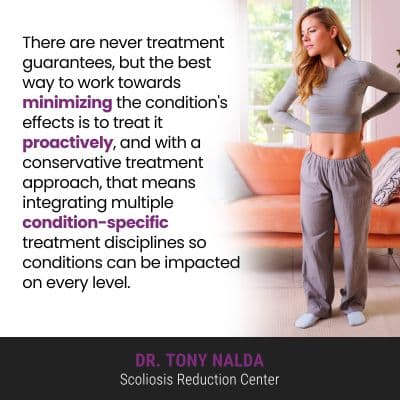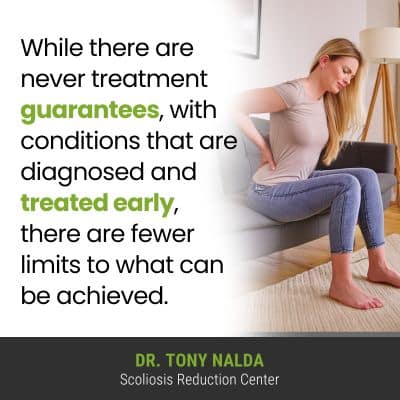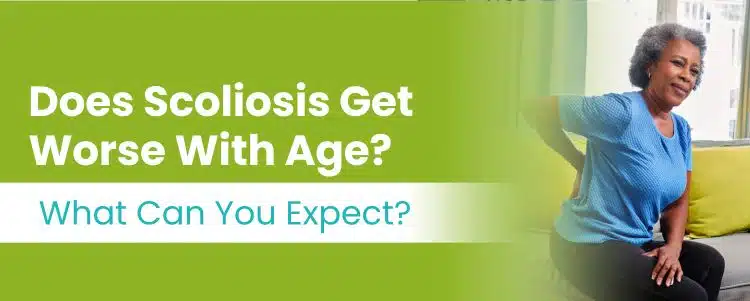Scoliosis gets worse with age in regards to progression, pain, and condition effects. How quickly scoliosis progresses is case-specific and will be shaped by a number of variables, the main one being patient age. As a progressive condition triggered by growth spurts, for children diagnosed, conditions get worse with age because of growth; in adults, scoliosis can get worse as the spine starts to experience age-related degenerative changes.
Scoliosis is a progressive condition, which means it has it in its nature to get worse over time, and that means the condition’s effects can also increase over time. The only way to fully counteract the condition’s progressive nature is to treat it proactively.
It can be difficult to prepare a patient freshly diagnosed with scoliosis for what’s coming because each case is unique, so let’s start with why.
Why Scoliosis Varies From Person to Person
Scoliosis is a highly-variable condition; no two cases will be the same, and what one patient experiences as part of life with the condition doesn’t necessarily indicate what others will face.
In order to diagnose scoliosis, an unnatural sideways-bending and twisting spinal curve has developed, and the curve also has to rotate, making scoliosis a complex 3-dimensional condition that needs to be addressed as such with treatment.
Scoliosis can affect all ages, but is most commonly diagnosed in children; however the actual rate of scoliosis increases with age, and this is because of age-related spinal degeneration.
In most cases, we don’t know what causes scoliosis to develop initially, but we do understand what makes it progress: growth.
Types of Scoliosis

Scoliosis ranges widely in severity from mild scoliosis to moderate, severe and very severe scoliosis, and there are also multiple condition types a person can develop from idiopathic scoliosis (the most prevalent), to atypical forms such as neuromuscular scoliosis, congenital scoliosis, and degenerative scoliosis.
In typical cases of idiopathic scoliosis, the abnormal curvature of the spine will bend to the right, away from the heart, but in atypical cases with an underlying pathology, curves can bend to the left, towards the heart.
There are three main sections of the spine: the cervical spine (neck), the thoracic spine (middle/upper back), and the lumbar spine (lower back), and scoliosis can develop in any one, or in more than one as a combined scoliosis.
So the type of scoliosis that develops, its severity, and location within the spine all play a role in shaping a person’s scoliosis-experience, and there are also different curvature types and patterns that have unique characteristics and treatment needs.
When it comes to progression, patient age is an important factor, and it’s progression that makes scoliosis get worse.
How Scoliosis Progresses
Scoliosis progresses for two main reasons: growth and spinal degeneration.
Scoliosis getting worse means the size of the unnatural spinal curve is increasing, as are the condition’s uneven forces, and their effects, and in children, the main effect is postural deviation, and in adults, it’s pain.
As scoliosis progresses from mild to moderate and severe to very severe scoliosis, a child’s posture can be disrupted in several ways that involve a disruption to the body’s overall symmetry.
In many cases, the condition’s earliest signs can include uneven shoulders, uneven hips, and the development of a rib cage arch, and as scoliosis progresses, these changes become more noticeable and can include an uneven eye line, waist line, arms and legs that seem to hang at different lengths, and disruptions to balance, coordination, and gait.
While having a single body asymmetry doesn’t guarantee a diagnosis of scoliosis, it does warrant the need for further testing, particularly if there is a family history of scoliosis; scoliosis isn’t considered a genetic condition, but is instead considered to be familial.
Having a family history of scoliosis is considered a risk factor, but families share a lot more than just their genes.
In adults, the main progression effect that increases is pain, and this is because scoliosis doesn’t become a compressive condition until adulthood has been reached, and it’s compression of the spine and its surrounding muscles and nerves that causes the majority of condition-related pain.
Progression Makes Scoliosis More Complex To Treat

While there are never treatment guarantees, with conditions that are diagnosed and treated early, there are fewer limits to what can be achieved.
As scoliosis gets more severe, the spine gets increasingly rigid, making it less responsive to treatment, and patients who have experienced significant progression can find it difficult to perform certain key therapeutic exercises as part of treatment; when this is the case, some preparatory work has to be done to restore a baseline level of spinal flexibility.
As scoliosis gets more severe, its effects are more overt, and the more likely it is to continue progressing as the spine becomes increasingly unstable and unbalanced, and this is why the actual rate of scoliosis increases with age.
When scoliosis effects become more pronounced, they are more difficult to reverse, and the longer scoliosis is left untreated and to progress unimpeded, the more likely developing related complications becomes.
Complications of severe and/or untreated scoliosis can include difficulty breathing (lung impairment), digestive issues, headaches that can reach migraine status, and chronic back pain, and the need for invasive spinal fusion surgery in the future.
Spinal fusion can straighten a bent spine, but the way it does so, by fusing multiple vertebral bodies together into one solid bone and attaching rods to the spine with pedicle screws, is contrary to its movement-based design so can cost the spine in other ways.
When scoliosis is diagnosed early in the condition’s progressive line and treatment is applied, progression can be prevented, as can the need for invasive spinal fusion surgery in the future.
How to Prevent Scoliosis Getting Worse with Age
There are never treatment guarantees, but the best way to work towards minimizing the condition’s effects is to treat it proactively, and with a conservative treatment approach, that means integrating multiple condition-specific treatment disciplines so conditions can be impacted on every level.
Through the combination of chiropractic care, physical therapy, corrective bracing, and rehabilitation, conditions can be, first and foremost, impacted on a structural level in the form of a curvature reduction.
Through a series of manual chiropractic adjustments and techniques, I can work towards adjusting the curve’s most-tilted vertebrae back into alignment with the rest of the spine.
Once I have started to reduce the curvature size, I can shift the focus to increasing core muscles strength for better spinal support and stabilization.
A spine that has optimal support and stability is one that can maintain its alignment and healthy curves.
Corrective bracing can be particularly effective on growing spines so is commonly part of childhood scoliosis treatment, and bracing for adults is more about short-term pain relief and improved spinal stability.
Rehabilitation can involve continued chiropractic care and a series of custom-prescribed home exercises designed to further heal and stabilize the spine from home.
Regardless of patient age, condition type, severity, or curvature location, as a progressive condition, the best way to prevent scoliosis from getting worse with age is to treat it proactively.
Conclusion
In the condition’s most-prevalent type, idiopathic scoliosis, it’s not so much age that causes scoliosis to progress, but growth; growth triggers scoliosis to get worse over time.
A patient can expect that if their scoliosis is left untreated, or isn’t treated proactively, it will get worse, and its effects will become more noticeable.
Once skeletal maturity has been reached in adulthood, growth tends to slow because the progressive trigger of growth has been removed, but once age-related spinal degeneration comes into play, the rate of progression can increase as the spine becomes more unstable.
Treating scoliosis effectively can shape the spine’s long-term spinal health and function, and the best way to minimize the condition’s effects is by preventing them, rather than attempting to reverse them once they’re established.
Scoliosis gets worse with age, not only due to growth, but also because the spine, like the rest of the body, is subject to degenerative changes, hence the prevalence of degenerative scoliosis in older adults.
In severe cases, complications can develop, and smaller curves are simpler to treat, so why not be proactive and start treatment as close to the time of diagnosis as possible; this is the best way to treat scoliosis while it’s at its mildest and is likely to be responsive.
Here at the Scoliosis Reduction Center®, my patients benefit from a modern proactive conservative treatment approach that combines multiple different types of treatment because this allows for the complete customization of treatment plans.




